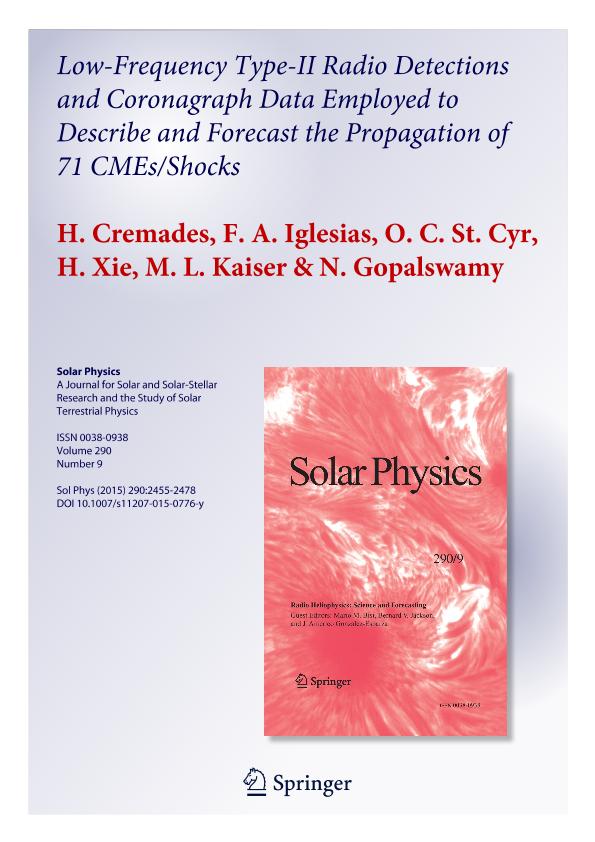Mostrar el registro sencillo del ítem
dc.contributor.author
Cremades Fernandez, Maria Hebe

dc.contributor.author
Iglesias, Francisco Andres

dc.contributor.author
St. Cyr, O. C.
dc.contributor.author
Xie, H.
dc.contributor.author
Kaiser, M. L.
dc.contributor.author
Gopalswamy, N.
dc.date.available
2022-12-05T17:02:24Z
dc.date.issued
2015-10
dc.identifier.citation
Cremades Fernandez, Maria Hebe; Iglesias, Francisco Andres; St. Cyr, O. C.; Xie, H.; Kaiser, M. L.; et al.; Low-Frequency Type-II Radio Detections and Coronagraph Data Employed to Describe and Forecast the Propagation of 71 CMEs/Shocks; Springer; Solar Physics; 290; 9; 10-2015; 2455-2478
dc.identifier.issn
0038-0938
dc.identifier.uri
http://hdl.handle.net/11336/180220
dc.description.abstract
Motivated by improving predictions of arrival times at Earth of shocks driven by coronal mass ejections (CMEs), we have analyzed 71 Earth-directed events in different stages of their propagation. The study is primarily based on approximated locations of interplanetary (IP) shocks derived from Type-II radio emissions detected by the Wind/WAVES experiment during 1997 – 2007. Distance–time diagrams resulting from the combination of white-light corona, IP Type-II radio, and in-situ data lead to the formulation of descriptive profiles of each CME’s journey toward Earth. Furthermore, two different methods for tracking and predicting the location of CME-driven IP shocks are presented. The linear method, solely based on Wind/WAVES data, arises after key modifications to a pre-existing technique that linearly projects the drifting low-frequency Type-II emissions to 1 AU. This upgraded method improves forecasts of shock-arrival times by almost 50 %. The second predictive method is proposed on the basis of information derived from the descriptive profiles and relies on a single CME height–time point and on low-frequency Type-II radio emissions to obtain an approximate value of the shock arrival time at Earth. In addition, we discuss results on CME–radio emission associations, characteristics of IP propagation, and the relative success of the forecasting methods.
dc.format
application/pdf
dc.language.iso
eng
dc.publisher
Springer

dc.rights
info:eu-repo/semantics/openAccess
dc.rights.uri
https://creativecommons.org/licenses/by-nc-sa/2.5/ar/
dc.subject
CORONAL MASS EJECTIONS, INITIATION AND PROPAGATION
dc.subject
RADIO BURSTS, TYPE II
dc.subject
WAVES, SHOCK
dc.subject.classification
Astronomía

dc.subject.classification
Ciencias Físicas

dc.subject.classification
CIENCIAS NATURALES Y EXACTAS

dc.title
Low-Frequency Type-II Radio Detections and Coronagraph Data Employed to Describe and Forecast the Propagation of 71 CMEs/Shocks
dc.type
info:eu-repo/semantics/article
dc.type
info:ar-repo/semantics/artículo
dc.type
info:eu-repo/semantics/publishedVersion
dc.date.updated
2022-12-05T15:06:23Z
dc.journal.volume
290
dc.journal.number
9
dc.journal.pagination
2455-2478
dc.journal.pais
Alemania

dc.journal.ciudad
Berlin
dc.description.fil
Fil: Cremades Fernandez, Maria Hebe. Consejo Nacional de Investigaciones Científicas y Técnicas; Argentina. Universidad Tecnológica Nacional. Facultad Regional de Mendoza; Argentina
dc.description.fil
Fil: Iglesias, Francisco Andres. Universidad Tecnológica Nacional. Facultad Regional de Mendoza; Argentina. Max Planck Institut Fuer Sonnensystemforschung; Alemania
dc.description.fil
Fil: St. Cyr, O. C.. National Aeronautics and Space Administration; Estados Unidos
dc.description.fil
Fil: Xie, H.. National Aeronautics and Space Administration; Estados Unidos
dc.description.fil
Fil: Kaiser, M. L.. No especifíca;
dc.description.fil
Fil: Gopalswamy, N.. National Aeronautics and Space Administration; Estados Unidos
dc.journal.title
Solar Physics

dc.relation.alternativeid
info:eu-repo/semantics/altIdentifier/url/https://link.springer.com/article/10.1007/s11207-015-0776-y
dc.relation.alternativeid
info:eu-repo/semantics/altIdentifier/doi/http://dx.doi.org/10.1007/s11207-015-0776-y
Archivos asociados
